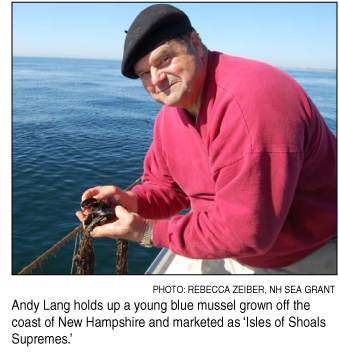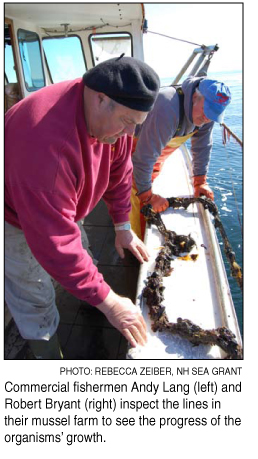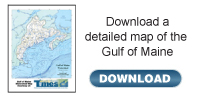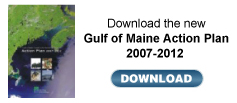Blue mussel farming as supplemental income
By Rebecca Zeiber
 Andy Lang has a simple Darwinian outlook to his career: “Adapt or perish.” Andy Lang has a simple Darwinian outlook to his career: “Adapt or perish.”
He’s been relatively successful at adapting over the years, maintaining the family tradition of fishing in conjunction with his landscaping business in Greenland, New Hampshire. But Lang’s recent efforts to diversify as a fisherman have brought about a new type of work for him—blue mussel farming.
Lang’s efforts to raise and harvest blue mussels in a submerged offshore farm are thought to be the first such activity in the United States. The mussel farm, located a few miles off the coast of New Hampshire near the Isles of Shoals, raises the shellfish on a set of longlines submerged 30 feet (9 meters) under the water.
Lang was recently awarded an $80,000 grant from the U.S. Department of Agriculture’s Small Business Innovation Research (SBIR) program. The SBIR grant will help enable Lang and researchers at the University of New Hampshire to increase the operation’s efficiency and ensure it is economically viable for other fishermen.
“When you’re the guinea pig, it’s both scary and exciting,” Lang said. “You don’t know if you’re going to go broke or be successful. But I’m in it for the long haul.”
His persistence and ability to adapt has allowed Lang to continue fishing, an interest that came about when he lived in North Weymouth, Massachusetts, as a child.
“I fished for rock cod and codfish right off the beach when I was a kid,” Lang recalled. “I used to ice down about half a dozen fillets and put them in my little red wagon and walk up and down the streets selling them to folks,” he chuckled.
Since that time, Lang has experienced some of the hardships of being a commercial fisherman in New England. He still uses his 61-foot (more than 18-meter) aluminum trawler to fish for scallops and shrimp in the winter, but with rising costs for boat fuel, maintenance and seafood transportation, he has had to think outside the box.
“I had to diversify to make ends meet,” Lang said. That’s when he heard about the effort by the University of New Hampshire (UNH) Open Ocean Aquaculture (OOA) program—now known as the Atlantic Marine Aquaculture Center—to encourage local fishermen to begin mussel farming for supplemental income. In 2005, he received the country’s first permits to farm mussels in the open ocean.
Persistence, innovation and technical help from UNH have kept the mussel farm going thus far. The SBIR grant will enable Lang and researchers like Ken La Valley, New Hampshire Sea Grant commercial fisheries specialist, to try different strategies to maximize efficiency over the next two years.
It doesn’t take long to discover that Lang is brimming with new ideas on how to make mussel farming an alternative for struggling New England fishermen.
Traditionally, the mussel seed is collected on a longline rope during the winter and spring spawning periods. This means sacrificing the number of lines used to grow out the adult mussels, La Valley explained. He and Lang are designing different line configurations, such as those that float above the grow-out lines, to make sure the space is used efficiently. Different types of rope material used for seed collection will be tested as well, but new techniques require money.
 “This grant gives us some help,” Lang said. “We don’t have deep pockets, but there are so many different things I want to try to do, such as tie the lines differently and use different materials. We want this to be a complete farm for mussels, one-stop shopping.” “This grant gives us some help,” Lang said. “We don’t have deep pockets, but there are so many different things I want to try to do, such as tie the lines differently and use different materials. We want this to be a complete farm for mussels, one-stop shopping.”
Lang discusses another challenge they have faced: many of the mussel shells break during processing. The relatively thin shells of the open ocean mussels are easily broken by the rough brushes meant to separate the individuals and remove grit and sand, and those with broken shells cannot be sold to local restaurants.
However, Lang has some ideas for meeting that challenge. The blue mussels raised in the open ocean do not take in much sand or grit the way traditionally farmed mussels do, he explained. They don’t need much scrubbing, so he wants to experiment with changing the brushes to barrel rollers or simply rinsing the shells as an alternative.
La Valley added that the SBIR grant will allow funds to be used for optimizing harvesting yields and improving storage and handling techniques to extend the shelf life of the mussels.
“We want to build upon the groundwork laid by the OOA program and take it to the next level,” La Valley said. “The grant is geared to make small business work, and Andy has the best shot of anyone to make this work.”
But for Lang, the work isn’t about any one individual. “This isn’t about me or about money. But when you’re the first guy to try something new you need a little help,” he said. “This grant isn’t a donation. It’s a way to learn information that we’ll give back to the government and to other fishermen about making this a feasible business.”
“It takes time to produce a quality product,” Lang added. “You reap what you sow. You hear that all the time in so many different ways, but it’s really true. If you want something nice, you need to put good effort into cultivating it.”
For more information see the Summer 2007 issue of the Gulf of Maine Times.
Rebecca Zeiber writes for New Hampshire Sea Grant in Durham, New Hampshire.
|








